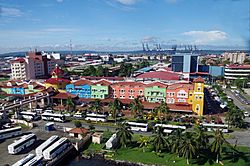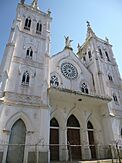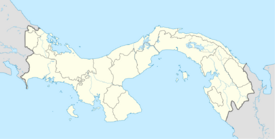Colón, Panama facts for kids
Quick facts for kids
Colón
|
|||
|---|---|---|---|
| Ciudad de Colón | |||
|
Top to bottom, left to right: Aerial view of Colón, November 5 Park located at the Historic District of Colón, Colón Free Trade Zone, Statue of Christopher Columbus, and the Inmaculate Conception Cathedral.
|
|||
|
|||
| Country | |||
| Province | Colón Province | ||
| District | Colón District | ||
| Elevation | 9 m (30 ft) | ||
| Population
(2016)
|
|||
| • City | 78,000 | ||
| • Metro | 241,817 | ||
| Time zone | UTC−5 (Eastern) | ||
| Area code(s) | +507 | ||
| Climate | Am | ||
| Website |
|
||
Colón (Spanish pronunciation: [koˈlon]) is a city and seaport in Panama, beside the Caribbean Sea, lying near the Atlantic entrance to the Panama Canal. It is the capital of Panama's Colón Province and has traditionally been known as Panama's second city. Originally it was located entirely on Manzanillo Island, surrounded by Limon Bay, Manzanillo Bay, and the Folks River; however, since the disestablishment of the Panama Canal Zone, the city's limits have been redefined to include Fort Gulick, a former U.S. Army base, as well as the former Panama Canal Zone towns of Cristobal, Margarita, and Coco Solo.
Contents
History
The city was founded in 1850 as the Atlantic terminal of the Panama Railroad, then under construction to meet the demand during the California Gold Rush for a fast route to California. For a number of years early in its history, the sizable United States émigré community called the town Aspinwall after Panama Railroad promoter William Henry Aspinwall, while the city's Hispanic community called it Colón in honor of Christopher Columbus. The city was founded on the western end of a treacherously marshy islet known as Manzanillo Island. As part of the construction of the Panama Railroad, the island was connected to the Panamanian mainland by a causeway and part of the island was drained to allow the erection of permanent buildings.
Much of the city was destroyed in the Burning of Colón during the Colombian Civil War of 1885 and again during a massive fire in 1915. The Great Colón Fire of April 13–14, 1940 destroyed one-third of the city.
The 1914 boundary treaty made Colón an exclave of the Republic of Panama entirely surrounded by the Panama Canal Zone. Under the 1936 Hull–Alfaro Treaty, the United States ceded the "Colón Corridor" from the Canal Zone; this was a strip under Panamanian jurisdiction just wide enough to build a road 4 miles (6.4 km) long connecting the city to the main eastern portion of the republic. During Panamanian nationalist unrest from the 1950s onwards, the U. S. military sometimes established checkpoints along the Colón Corridor, feeding the resentment that had led to the unrest.
Fort De Lesseps
Fort De Lesseps was a small U.S. Army Coast Artillery Corps fort located at the northern tip of the city. It was named after the canal developer Ferdinand de Lesseps.
From 1948 to 1989
In 1948, the southeastern corner of Manzanillo Island was designated as the Colón Free Trade Zone. The Free Trade Zone has since been expanded through land reclamation on the Folks River and annexation of parts of France Field (now Enrique Adolfo Jiménez Airport) and Coco Solo.
Politically instigated riots in the 1960s destroyed the city's municipal palace and signaled the start of the city's decline, which was further accelerated by the military dictatorships of Omar Torrijos and Manuel Noriega from 1968 to 1987.
Since late 2014
A massive restoration and reconstruction project, involving parks, avenues and historic buildings and monuments, began in late 2014 and uses the hashtags "#RenovaciónColón", "#CiudadDeColón", "#RenovationColon (Renovation of Colón)" and "#CityOfColon". The First Baptist Church of Colón, Panama, is one of the buildings whose renovation has been completed.
Climate
Like most of the Caribbean coast of Central America, Colón possesses an extremely wet tropical climate owing to the powerful, wet trade winds flowing onto high mountains throughout the year. Unlike most parts of this coast, however, February and March are sufficiently dry that Colón fits into the tropical monsoon climate (Köppen Am) category rather than a tropical rainforest climate (Af) as found in most Caribbean coastal areas. Nonetheless, the June-to-December period, with an average monthly rainfall of around 415 mm or 16.3 in, is so wet that Colón rivals La Ceiba, Honduras as the wettest sizable city in Central America.
| Climate data for Colón | |||||||||||||
|---|---|---|---|---|---|---|---|---|---|---|---|---|---|
| Month | Jan | Feb | Mar | Apr | May | Jun | Jul | Aug | Sep | Oct | Nov | Dec | Year |
| Mean daily maximum °C (°F) | 29 (84) |
29 (84) |
29 (85) |
30 (86) |
31 (87) |
30 (86) |
29 (85) |
29 (85) |
31 (87) |
30 (86) |
29 (84) |
29 (84) |
29 (85) |
| Mean daily minimum °C (°F) | 24 (76) |
24 (76) |
24 (76) |
25 (77) |
24 (76) |
24 (75) |
24 (75) |
24 (75) |
24 (75) |
23 (74) |
23 (74) |
24 (75) |
24 (75) |
| Average rainfall mm (inches) | 110 (4.3) |
51 (2.0) |
36 (1.4) |
94 (3.7) |
270 (10.8) |
370 (14.5) |
420 (16.5) |
420 (16.4) |
290 (11.5) |
470 (18.4) |
620 (24.4) |
320 (12.6) |
3,471 (136.5) |
| Source: Weatherbase | |||||||||||||
Population
Colón's population in 1900 was 3,001. It grew significantly with the building of the Panama Canal, becoming 31,203 by 1920. In 2000, the population was around 204,000.
With the city's economic decline, many of its upper and middle-class residents left, reducing its ethnic diversity. European and American expatriate communities, as well as Panamanians of Greek, Italian, Jewish, Chinese and Indian/South Asian heritage, started moving to Panama City, to former Canal Zone towns, and overseas.
Today, sizable South Asian and Arab communities live in the remaining prosperous areas of the city, as well as in gated communities outside it. The majority of the city's population is of West Indian or mixed mestizo ancestry.
Sports
Colón is home to Correcaminos Colon, 2016 Basketball Champion of Panama and member of the FIBA Americas League. The team plays its home games at the Arena Teófilo "Panamá" Al Brown.
Transport
The city is served by the Panama Canal Railway and Enrique Adolfo Jiménez Airport.
People from Colón
Athletes
- Rod Carew, Major League Baseball player, inducted in 1991 to the Baseball Hall of Fame, selected to the Major League Baseball All-Century Team
- Rennie Stennett, Major League Baseball second baseman for the 1979 World Series Champion Pittsburgh Pirates.
- Alfonso "Panama" Al Brown, boxer, first Hispanic World Champion, World Bantamweight Champion between 1929 and 1934, induced in 1992 to International Boxing Hall of Fame
- George Headley (1909-1983), West Indies cricketer born in Colón; the only person from Panama to play Test cricket.
- Miguel Iriarte, boxer, fought for the WBA world Bantamweight title in 1982
- Ismael Laguna, boxer, World Featherweight Champion in 1965 and 1970, inducted in 1999 to World Boxing Hall of Fame and in 2001 to International Boxing Hall of Fame
- Jorge Lujan, boxer, WBA and Ring Magazine world Bantamweight champion
- Irving Saladino, athlete, long jump, 2007 World Champion and 2008 Olympic gold medalist, first gold medalist of the nation
- Manny Sanguillén, catcher for the Pittsburgh Pirates
- Armando Dely Valdés, football player
- Jorge Dely Valdés, football player
- Julio Dely Valdés, football player
- Celestino Caballero, boxer, WBA Super Bantamweight Champion 2005–present, IBF Super Bantamweight Champion 2008–present
- Ben Oglivie, Major League Baseball player for the Boston Red Sox, Detroit Tigers, and the Milwaukee Brewers
- Gary Forbes, National Basketball Association player, Small Forward for the Houston Rockets.
- Ruben Garces, College and Professional basketball player, Power Forward and center. Phoenix and Golden State He has also played in the American CBA, the Spanish ACB, in Argentina, Venezuela, and France
See also
 In Spanish: Colón (Panamá) para niños
In Spanish: Colón (Panamá) para niños












